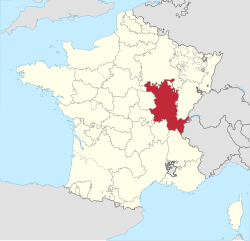
Back Hertogdom van Boergondië Afrikaans دوقية برغونية Arabic Ducáu de Borgoña AST Burqundiya hersoqluğu Azerbaijani Герцагства Бургундыя Byelorussian Бургундско херцогство Bulgarian Dugelezh Bourgogn Breton Ducat de Borgonya Catalan Burgundské vévodství Czech Hertugdømmet Burgund Danish
Duchy of Burgundy | |||||||||
|---|---|---|---|---|---|---|---|---|---|
| 880–1790 | |||||||||
 The Duchy of Burgundy within France on the eve of the French Revolution | |||||||||
| Status | Vassal of the Kingdom of France | ||||||||
| Capital | Dijon | ||||||||
| Common languages | |||||||||
| Religion | Roman Catholicism | ||||||||
| Demonym(s) | Burgundian | ||||||||
| Government | Feudal monarchy | ||||||||
| Duke of Burgundy | |||||||||
• 1032–1076 | Robert I | ||||||||
• 1363–1404 | Philip the Bold | ||||||||
• 1404–1419 | John the Fearless | ||||||||
• 1419–1467 | Philip the Good | ||||||||
• 1467–1477 | Charles the Bold | ||||||||
| Legislature | Estates of Burgundy | ||||||||
| Historical era | Middle Ages | ||||||||
• Established | 880 | ||||||||
| 1002 | |||||||||
| 1337–1453 | |||||||||
| 1384 | |||||||||
| 1430 | |||||||||
| 1474–1477 | |||||||||
| 1477–1482 | |||||||||
• Duchy absorbed into French royal domain | 1790 | ||||||||
| Currency | goldgulden, stuiver, gros[1] | ||||||||
| |||||||||
| Today part of | France | ||||||||
The Duchy of Burgundy (/ˈbɜːrɡəndi/; Latin: Ducatus Burgundiae; French: Duché de Bourgogne) emerged in the 9th century as one of the successors of the ancient Kingdom of the Burgundians, which after its conquest in 532 had formed a constituent part of the Frankish Empire. Upon the 9th-century partitions, the French remnants of the Burgundian kingdom were reduced to a ducal rank by King Robert II of France in 1004. Robert II's son and heir, King Henry I of France, inherited the duchy but ceded it to his younger brother Robert in 1032.[2]
The other portions of the Kingdom of the Burgundians had passed to the Imperial Kingdom of Burgundy-Arles, including the County of Burgundy (Franche-Comté).[3]
Robert became the ancestor of the ducal House of Burgundy, a cadet branch of the royal Capet dynasty, ruling over a territory that roughly conformed to the borders and territories of the modern region of Burgundy (Bourgogne). Upon the extinction of the Burgundian male line with the death of Duke Philip I in 1361, the duchy reverted to King John II of France and the royal House of Valois. The Burgundian duchy was absorbed in a larger territorial complex after 1363, when King John II ceded the duchy to his younger son Philip. With his marriage with Countess Margaret III of Flanders, he laid the foundation for a Burgundian State which expanded further north in the Low Countries collectively known as the Burgundian Netherlands. Upon further acquisitions of the County of Burgundy, Holland, and Luxemburg, the House of Valois-Burgundy came into possession of numerous French and imperial fiefs stretching from the western Alps to the North Sea, in some ways reminiscent of the Middle Frankish realm of Lotharingia.[4]
The Burgundian State, in its own right, was one of the largest ducal territories that existed at the time of the emergence of Early Modern Europe. After just over one hundred years of Valois-Burgundy rule, however, the last duke, Charles the Bold, rushed to the Burgundian Wars and was killed in the 1477 Battle of Nancy. The extinction of the dynasty led to the absorption of the duchy itself into the French crown lands by King Louis XI, while the bulk of the Burgundian possessions in the Low Countries passed to Charles' daughter, Mary, and her Habsburg descendants.[5]
- ^ Robert A. Levinson, The Early Dated Coins of Europe, 1234–1500, Coin & Currency Institute, 2007, p. 113.
- ^ "Burgundy - Roman, Medieval, Renaissance | Britannica". www.britannica.com. Retrieved 2024-01-09.
- ^ "Histoire de la Bourgogne". Mon coin de Bourgogne (in French). 2022-04-16. Retrieved 2024-01-09.
- ^ "Les Etats bourguignons (1363-1477) - Réussite et déclin d'une principauté pendant la Guerre de Cent Ans (I)". Histoire d'en Parler (in French). Retrieved 2024-01-09.
- ^ "Histoire Abrégée Du Duché De Bourgogne, Depuis Les Eduens, Les Lingons Et Les Séquanois, Jusqu'à La Réunion De La Province À La Couronne Sous Louis Xi.... | Indigo". www.indigo.ca. Retrieved 2024-01-09.
© MMXXIII Rich X Search. We shall prevail. All rights reserved. Rich X Search


